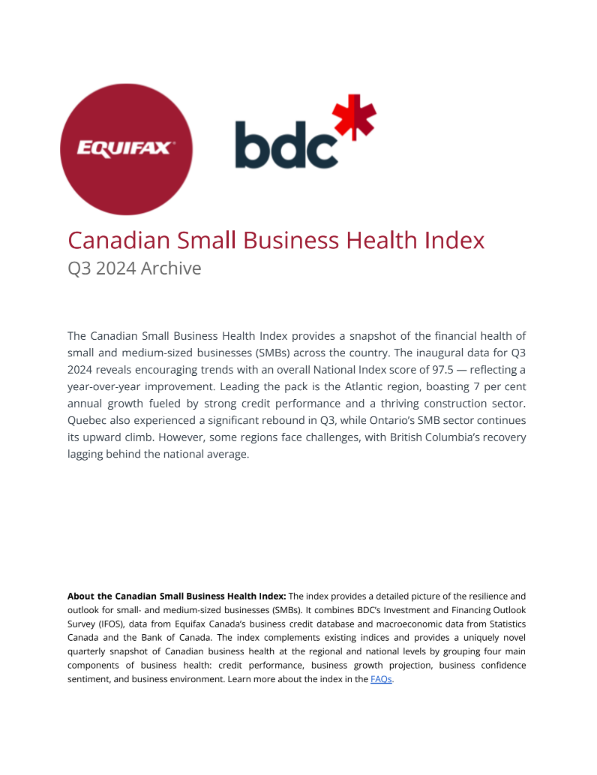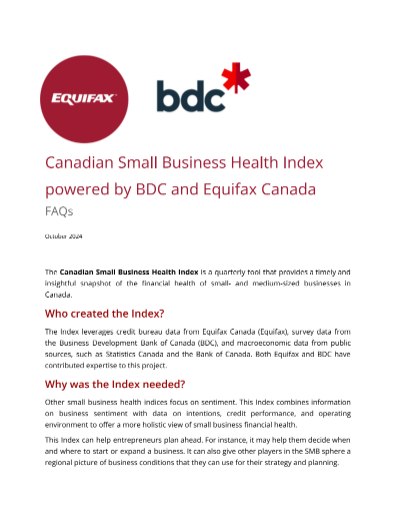The State of Canadian Small Business Health: Q2 2025 Performance
Canada: A cautious outlook clouds growth prospects
Canadian Small Business Health Index, Q2 2025
97.0
Year-over-year difference
-1.6%
Difference over the previous quarter
-2.5%
The national index continued its descent in Q2 2025, falling to 97.0, a 2.5% decline from the last quarter. The materialization of tariffs on certain Canadian exports to the U.S. and to China darkened the economic outlook at the beginning of the second quarter. As a result, business sentiment weakened further in Q2, prompting many SMBs to pause their growth projects. However, so far, the economic impact of these tariffs has been less severe than anticipated earlier in the year.
Overall, some optimism has returned since the second quarter as consumers continue to spend. Businesses seem to have avoided their worst-case scenario as it relates to trade tensions, however, confidence remains subdued. Read the full report here.
Atlantic: A challenging quarter
The Index dropped by 7.8% in Q2, falling to 93.8, its lowest level since the start of the index. After a confident start to 2025, SMBs in Atlantic regions felt the weight of the shifting markets. The decline was largely driven by weaker growth projections and deteriorating business sentiment. Economic uncertainty remained a key concern, with a 25% tariff on seafood exports to China particularly impactful to Nova Scotia and New Brunswick economies. Read the full report here.
Quebec: Confidence slipped in Q2
Quebec’s Index dropped sharply in Q2, falling to 95.9, a level in-line with the weakest moments in 2023. This decline reflects a significant deterioration in business sentiment and growth projections, which fell by 16.8% and 6.8%, respectively, compared to Q1 2025. Despite these challenges, the broader economic environment remained relatively stable through Q2. Read the full report here.
Ontario: Business outlook offsetting improving macroeconomic factors
Ontario’s index came in at 97.5 in Q2 2025, a decline of 1.5% from Q1 2025 and similar levels observed in 2023. The business environment in Ontario continues to remain healthy, partly offsetting declines in other components of the index on an annual and quarterly basis. A stable inflation around the Bank of Canada’s target and a resilient labour market continued with normalizing bond yield spreads contributing to this improvement. Read the full report here.
Manitoba and Saskatchewan: Sentiment weighs on growth prospects despite a stronger environment
The index for Manitoba and Saskatchewan declined for a second consecutive quarter, to 102.9, a 0.9% decrease from Q1 2025. However, the index remains higher year-over-year versus Q1 2024. A significant drop in business sentiment largely drove this quarter’s decline, which fell 7.8% quarter-over-quarter, mainly due to concerns surrounding the economic outlook. Despite a cautious outlook, the current business environment recorded a substantial improvement, rising by 4.4% compared to the previous quarter as the employment rate registered some gains. Read the full report here.
Alberta: Outlook pessimism weighing on strong economy performance
Alberta’s index is down to 2023 levels at 98.2 (down 3% quarter-over-quarter and 3.6% year-over-year).This is due to a weakening economic outlook that has depressed consumer spending, even though the macroeconomic environment is improving. Despite remaining below last year’s level, credit performance is a bright spot compared to last quarter (up 0.2%), as both delinquency rates and overdue amounts declined. Read the full report here.
British Columbia: Sentiment slips further
The index in British Columbia fell to 93.9 last quarter, a 1.1% decline from the previous quarter and 4.9% year-over-year. Deteriorating business sentiment was the primary driver of this decline, weighing on the index both quarterly and annually. This growing pessimism also dampened growth expectations. There are some signs of recovery in SMBs’ financial health. The credit performance rose 0.4% quarter-over-quarter. Read the full report here.






